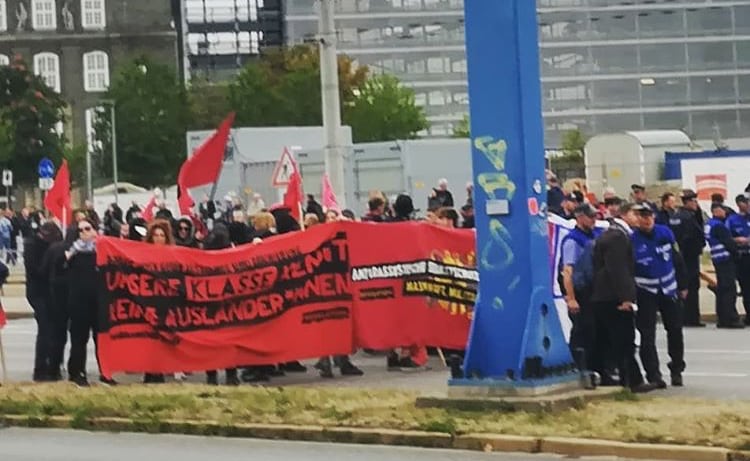

By Svenja Spunck
ABOUT 5000 right-wingers rampaged through Chemnitz on Monday, August 27. The march was organised by Nazis and extreme nationalist groups and, coming just a day after a riot by a mob of more than 800 violent neo-Nazis, is a shocking warning signal. They marched through Chemnitz city centre without any challenge from the police. On both days, videos that went viral on the social networks showed attacks on people who they thought “looked like immigrants” and many in the huge mob blatantly giving the Hitler salute and chanting racist slogans. The police remained largely passive in the face of this, even when they themselves were showered with bottles.
The excuse for the neo-Nazi gathering was the death of a 35-year-old man who was stabbed in an argument on Sunday. The online right-wing scene quickly spread the rumour that the perpetrators were foreigners and that people should take to the streets against them. The organisers came from the Alternative for Germany, AfD, Pro Chemnitz, a “Citizens Movement” and anti-immigrant party, and their comrades-in-arms amongst the football hooligans of “Kaotic Chemnitz”.
Contrast the police response or rather non-response with what happened after the demonstration against the G20 summit in Hamburg, an 18-year-old Italian, Fabio V. was held in custody for five months, although he had not been accused of as much as throwing a stone. In Chemnitz, however, rightwing extremists known to the Saxon security service, were allowed to march through the streets and attack immigrants with impunity. For those who think the police were simply “overwhelmed” comments at a press conference by Saxony’s Prime Minister, Michael Kretschmer, and his Interior Minister Wöller, both of the Christian Democratic Union, CDU, are instructive. They characterised the police performance as “damn good”.
As with the memorial march for the Nazi deputy führer Rudolf Hess in central Berlin the previous week, successful policing no longer means stopping right wingers from marching but rather ensuring they can. Had the trial of the far-right terror cell known as the National Socialist Underground, NSU, accused of murdering a number of immigrants, not ended recently with mild punishments and no investigation of the role of the Federal Office for the Protection of the Constitution, one would perhaps have been surprised by this assessment.
But, at the latest since it became known that police employees, such as “Maik” with the black-red-yellow fisherman’s hat, participate in Pegida demonstrations in their free time, one may no longer assume that the police only turn a blind eye to the right. What is more, the extreme right is gradually penetrating the state structures, as the recently uncovered talks between the head of the Federal Office for the Protection of the Constitution, Hans-Georg Maaßen, and several members of the AfD show. So, when the government talks about giving the monopoly of force back to the police, what that actually means is extreme right-wing violence carried out with state legitimacy.
Warning shot
The riots in Chemnitz are another warning shot for the left in Germany. At the beginning of 2016, around 200 neo-Nazis attacked Leipzig’s Connewitz district, a left and anti-fascist area, and left it in ruins. The “hooligans against salafists” action in Cologne, in early 2014, showed that such racist marches are not just an “Eastern” phenomenon.
Nevertheless, the economic decline of the former DDR states remains a real problem in Germany to this day, with the far right taking advantage of the dire conditions above all in rural areas and in “isolated” small and medium-sized towns and channeling the fear of social decline. No wonder that the Pegida movement, whose main enemy is Angela Merkel, who they blame for the influx of Muslim refugees, began in Dresden, Saxony’s capital.
The left’s weakness came to light in Chemnitz this weekend. Against the Nazi demonstration, spontaneously mobilised nationwide, only 1000 counter-demonstrators took to the streets. Again and again, the Nazis broke through the police lines and attacked the counter-demonstrators and journalists. The chair of Die Linke in Chemnitz, Tim Detzner said, “The scenes of hunting down people who look like foreigners is frightening. We want to show that Chemnitz has a different face: ‘cosmopolitan and against xenophobia'”.
Whilst the fear is understandable, the decisive question is how do we counter it, how do we respond to the right danger, how do we turn fear of the Nazis and racists into courage to stand up to them. On the order of the day is the building of a broad anti-fascist united front of the left, the trade unions, the workers’ and migrant organisations in Saxony and throughout Germany. This includes organising self-defence for our demonstrations and actions, for the defence of refugee hostels, leftist centres and meeting rooms. This time the neo-Nazis “only” marched through the city centre, but the fact that this march could take place unhindered will certainly have boost the self-confidence of their organisations.
There must be no reliance on the police or the state to protect us from even more serious attacks. We have seen how quickly and effectively the right can organise nationwide and it is time to do something about it. Pacifist speeches and sit-downs will not be effective against Nazi marches. To break up and demoralise their organisations, antifascist resistance is called for; militant, well-organised and on a massive scale. We need defence groups, organised where we live and work; in local districts, in schools and universities, in offices and in factories, an organisation that can mobilise quickly and effectively nationwide to “hot spots” against the nationwide mobilisations of the Nazis.